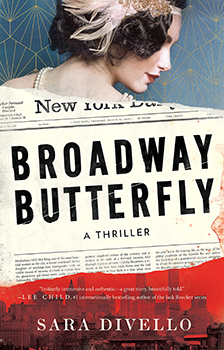

Features Sara DiVello
BROADWAY BUTTERFLY: Glamour…Money…and Murder
Novelist, creator of The Thriller Mavens podcast, and ITW Director of Social Media Strategy Sara DiVello made her true crime thriller debut on August 1 with a powerhouse story.
Imagine New York City, 1923. Young and gorgeous, flapper Dot King lives a scandalous life in the tabloid headlines, complete with money, jewels, furs, boyfriends, and a sugar daddy. Until the morning her housekeeper finds her dead in bed, the victim of chloroform asphyxiation.
Did the maid, Ella Bradford, kill Dot? Or was it Dot’s former roommate, the Broadway showgirl Hilda? Or her abusive boyfriend, Albert Guimares? Her sugar daddy, the mysterious and powerfully connected “Mr. Marshall?” Or any of a number of hangers-on, lovers, or parasites?
As Detective John D. Coughlin fights city politicians determined to cover up the truth, notorious tabloid journalist Julia Harpman digs for dirt, hampered by the male-dominated news business, but determined to find out who killed Dot King. What she uncovers will stun you.
After reading this fascinating true story, we had questions for author Sara DiVello.
What led you to write true crime?
I’ve always subscribed to the Mark Twain school of thought: Truth is stranger than fiction. As a huge true crime fan, I watch documentaries like “The Staircase,” “Dirty John,” and most recently, “Missing: Dead or Alive,” and I listen to podcasts like “Serial,” “To Live and Die in LA,” and “Missing and Murdered.” I’m fascinated by the craziness of the truth, and I’m obsessed with finding answers.
The joy of writing a true story is that you can lean into the outrageous, the shocking, and the unbelievable because when someone says, “Pshaw, that would never happen!” You can say, “Oh, but it did.”
How did you hear about the murder of Dot King, and what inspired you to choose this particular crime for your book?
I learned about this crime entirely by accident. I was visiting family in Philadelphia when my uncle Ed reminisced about back in high school in the ’60s, sneaking cigarettes over at “the castle.” Known as the Versailles of America, it had long since been demolished, but some ruins remained. Needless to say, I needed to know more. So we piled into cars and caravanned over to check it out. There, between the Subarus and tulip beds of a subdivision, were, indeed, the remnants of a great estate: headless statues, the edge of a pool where a fountain had once gurgled, pillars that stretched 50 feet in the air…I was fascinated. When I learned the grand home was connected to a murder, I immediately knew this was a story I had to tell.
You’ve had a successful career in public relations and have also taught yoga. What inspired you to write true crime? They seem like such different pursuits.
I still use my PR skills today, teaching workshops around the country on how writers can use social media, PR, and branding. And while yoga may seem pretty darn opposite to true crime, its benefits, like a calmer mind and a pain-free body, are integral to writing. Yoga is also particularly helpful in navigating the often perilous path to publication with the stress of deadlines, the anxiety of reviews, the uncertainty and lack of control in how your work will be received and sold.
How did Mystery and Thriller Mavens begin?
I wanted to help my fellow mystery writers get the word out about their books and connect with readers during the pandemic. I partnered with Murder by the Book, a renowned, woman-owned, mystery-dedicated independent bookstore in Houston, Texas. Since then, I’ve created streaming partnerships with two mega book-focused Facebook groups to increase viewership and help my guests sell more books. It’s been three years and over 350 interviews, and we’re going stronger than ever.
In BROADWAY BUTTERFLY: A THRILLER, why was Julia Harpman your choice for a protagonist?
Julia Harpman was an extraordinary human being. Forgotten by history, she was one of the pioneering women in journalism and the lead crime reporter in New York City (irrespective of gender) at a time when about only 20% of women worked outside the home (compared to about 60% today). Julia had chutzpah and was courageous almost beyond comprehension. I hope to honor her remarkable life and her rightful place in history.
Detective John D. Coughlin also played a central role. Could he have done more to solve the crime?
Coughlin was in a tough spot. Cutthroat politics absolutely interfered with his ability to do his job. Could he have done more? Yes. But at what cost? I’ve struggled with this on a moral and ethical level. With cases piling up on his desk, other victims and families deserved justice, too. How many resources should the police allocate to one case?
Ella Bradford was also a key character. How did attitudes toward race in the 1920s affect the case?
Ella was such an incredible human being. When she was around 20 years old, she was one of seven million Black Americans to travel to the North in search of better lives. Ella got a job working for Dot King in midtown Manhattan. She became Dot’s closest friend and confidant. In spite of pervasive racism, Ella earned acknowledgment and respect from the police and the public as a wife and mother. “She kept a respectable home,” was an oft-repeated phrase in newspapers stated in stark contrast to her scandalous, sensational, and white boss.
I’ve always subscribed to the Mark Twain school of thought: Truth is stranger than fiction.
Tell us about your research for this book.
I spent years running leads to ground for this case. I interviewed detectives, subject-matter experts on everything from forensics, socioeconomic, race, and gender relations at the turn of the century, 1920s politics, and elections—even a psychic who works with law enforcement on cold cases. I spent many, many hours in the bowels of the New York Public Library and going through the Library of Congress’ online archives. I searched rare books collections and personal papers at presidential libraries. It was often frustrating, but there is no greater high when you finally get a hit. For example, after six or seven years of searching, I finally found Ella’s marriage certificate and two photos. They are some of my greatest treasures. Readers will see them, too, on a special behind-the-scenes section of my website.
Corruption played a big role in this world. Do you think we can learn anything today from the world of the 1920s?
Absolutely. One of the most important things I want to show in this book is that in the past 100 years, a lot has changed…and absolutely nothing has changed. The power of money and political influence to corrupt remains a threat to our institutions and to justice. I hope BROADWAY BUTTERFLY makes readers laugh and gasp and get wistful for what seems to have been a wildly fun time in the 1920s…but I also talk about race, class, gender, justice, power, politics, and how we can—and must—do better.
- Bruce Borgos - August 8, 2024
- The Big Thrill Recommends: SERVED COLD by James L’Etoile - July 26, 2024
- The Big Thrill Recommends: THE PARIS VENDETTA by Shan Serafin - June 27, 2024




